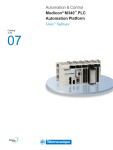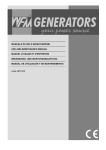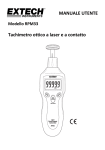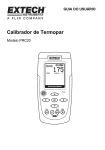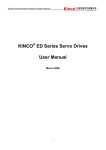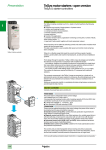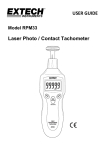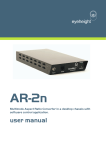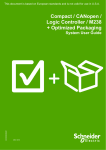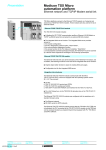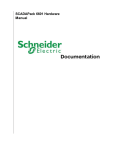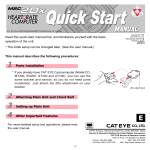Download Phaseo power outage solution User guide
Transcript
Phaseo power outage solution User guide W9 1489436 10 11 A01 03/2008 2 Table of Contents Safety Information . . . . . . . . . . . . . . . . . . . . . . . . . . . . . . . . . . . . 5 About the Book . . . . . . . . . . . . . . . . . . . . . . . . . . . . . . . . . . . . . . . 7 Chapter 1 Overview . . . . . . . . . . . . . . . . . . . . . . . . . . . . . . . . . . . . . . . . . . . . 9 Overview . . . . . . . . . . . . . . . . . . . . . . . . . . . . . . . . . . . . . . . . . . . . . . . . . . . . . . . . 9 Overview of the solution . . . . . . . . . . . . . . . . . . . . . . . . . . . . . . . . . . . . . . . . . . . 10 Presentation of Battery Modules ABL 8BPK24A•• . . . . . . . . . . . . . . . . . . . . . . . 11 Presentation of Battery control modules ABL 8BBU24•00. . . . . . . . . . . . . . . . . 12 Chapter 2 Choice of solution components . . . . . . . . . . . . . . . . . . . . . . . . 15 Choice of components. . . . . . . . . . . . . . . . . . . . . . . . . . . . . . . . . . . . . . . . . . . . . 15 Chapter 3 Implementation stages. . . . . . . . . . . . . . . . . . . . . . . . . . . . . . . . 19 Implementation stages . . . . . . . . . . . . . . . . . . . . . . . . . . . . . . . . . . . . . . . . . . . . 19 Chapter 4 Assembly and temperature conditions . . . . . . . . . . . . . . . . . . 21 Presentation . . . . . . . . . . . . . . . . . . . . . . . . . . . . . . . . . . . . . . . . . . . . . . . . . . . . 21 Mounting of the Battery module . . . . . . . . . . . . . . . . . . . . . . . . . . . . . . . . . . . . . 22 Mounting of Battery control module. . . . . . . . . . . . . . . . . . . . . . . . . . . . . . . . . . . 26 Chapter 5 Wiring. . . . . . . . . . . . . . . . . . . . . . . . . . . . . . . . . . . . . . . . . . . . . . 27 Overview . . . . . . . . . . . . . . . . . . . . . . . . . . . . . . . . . . . . . . . . . . . . . . . . . . . . . . . 24 VDC circuit wiring . . . . . . . . . . . . . . . . . . . . . . . . . . . . . . . . . . . . . . . . . . . . . . Diagnostics contact and inhibition input wiring . . . . . . . . . . . . . . . . . . . . . . . . . . Wiring of an auto power off circuit of the Battery Module . . . . . . . . . . . . . . . . . . Chapter 6 27 28 33 35 Setup . . . . . . . . . . . . . . . . . . . . . . . . . . . . . . . . . . . . . . . . . . . . . . 37 Overview . . . . . . . . . . . . . . . . . . . . . . . . . . . . . . . . . . . . . . . . . . . . . . . . . . . . . . . User interface . . . . . . . . . . . . . . . . . . . . . . . . . . . . . . . . . . . . . . . . . . . . . . . . . . . First powering on / Minimum setup . . . . . . . . . . . . . . . . . . . . . . . . . . . . . . . . . . . The SETTINGS Menu . . . . . . . . . . . . . . . . . . . . . . . . . . . . . . . . . . . . . . . . . . . . . Settings transfer by memory card type SR2 MEM02 . . . . . . . . . . . . . . . . . . . . . 37 38 40 42 47 3 Chapter 7 Diagnostic. . . . . . . . . . . . . . . . . . . . . . . . . . . . . . . . . . . . . . . . . . 51 Overview . . . . . . . . . . . . . . . . . . . . . . . . . . . . . . . . . . . . . . . . . . . . . . . . . . . . . . . 51 Diagnostic . . . . . . . . . . . . . . . . . . . . . . . . . . . . . . . . . . . . . . . . . . . . . . . . . . . . . . 52 Faults - causes - remedies. . . . . . . . . . . . . . . . . . . . . . . . . . . . . . . . . . . . . . . . . . 55 Chapter 8 Operation timing diagrams . . . . . . . . . . . . . . . . . . . . . . . . . . . . 57 Overview . . . . . . . . . . . . . . . . . . . . . . . . . . . . . . . . . . . . . . . . . . . . . . . . . . . . . . . 57 Timed function . . . . . . . . . . . . . . . . . . . . . . . . . . . . . . . . . . . . . . . . . . . . . . . . . . . 58 All functions (timed or max) : voltage feedback before module cut-off . . . . . . . . 59 Max function with long power outage (complete discharge of Battery module). . 60 Output behaviour in the case of overload or short-circuit . . . . . . . . . . . . . . . . . . 61 Chapter 9 Maintenance . . . . . . . . . . . . . . . . . . . . . . . . . . . . . . . . . . . . . . . . 63 Overview . . . . . . . . . . . . . . . . . . . . . . . . . . . . . . . . . . . . . . . . . . . . . . . . . . . . . . . 63 SERVICE menu . . . . . . . . . . . . . . . . . . . . . . . . . . . . . . . . . . . . . . . . . . . . . . . . . . 64 Battery modules replacement . . . . . . . . . . . . . . . . . . . . . . . . . . . . . . . . . . . . . . . 66 Appendices . . . . . . . . . . . . . . . . . . . . . . . . . . . . . . . . . . . . . . . . . . . . . . . 67 Overview . . . . . . . . . . . . . . . . . . . . . . . . . . . . . . . . . . . . . . . . . . . . . . . . . . . . . . . 67 Appendix A Characteristics . . . . . . . . . . . . . . . . . . . . . . . . . . . . . . . . . . . . . . 69 Overview . . . . . . . . . . . . . . . . . . . . . . . . . . . . . . . . . . . . . . . . . . . . . . . . . . . . . . . 69 Electrical Characteristics of the Battery control modules. . . . . . . . . . . . . . . . . . . 70 Operating and environmental characteristics of Battery control modules . . . . . . 71 Electrical characteristics of the Battery modules . . . . . . . . . . . . . . . . . . . . . . . . . 72 Operating and environmental characteristics of Battery modules . . . . . . . . . . . . 73 Appendix B Battery general information . . . . . . . . . . . . . . . . . . . . . . . . . . . 75 Battery Generalities . . . . . . . . . . . . . . . . . . . . . . . . . . . . . . . . . . . . . . . . . . . . . . . 75 Appendix C FAQ . . . . . . . . . . . . . . . . . . . . . . . . . . . . . . . . . . . . . . . . . . . . . . . 77 FAQ . . . . . . . . . . . . . . . . . . . . . . . . . . . . . . . . . . . . . . . . . . . . . . . . . . . . . . . . . . . 77 4 Glossary . . . . . . . . . . . . . . . . . . . . . . . . . . . . . . . . . . . . . . . . . . . . . . . 79 Index . . . . . . . . . . . . . . . . . . . . . . . . . . . . . . . . . . . . . . . . . . . . . . . 81 Safety Information § Important Information NOTICE Read these instructions carefully, and look at the equipment to become familiar with the device before trying to install, operate, or maintain it. The following special messages may appear throughout this documentation or on the equipment to warn of potential hazards or to call attention to information that clarifies or simplifies a procedure. The addition of this symbol to a Danger or Warning safety label indicates that an electrical hazard exists, which will result in personal injury if the instructions are not followed. This is the safety alert symbol. It is used to alert you to potential personal injury hazards. Obey all safety messages that follow this symbol to avoid possible injury or death. DANGER DANGER indicates an imminently hazardous situation, which, if not avoided, will result in death or serious injury. WARNING WARNING indicates a potentially hazardous situation, which, if not avoided, can result in death, serious injury, or equipment damage. CAUTION CAUTION indicates a potentially hazardous situation, which, if not avoided, can result in injury or equipment damage. W9 1489436 10 11 A01 03/2008 5 Safety Information PLEASE NOTE Electrical equipment should be installed, operated, serviced, and maintained only by qualified personnel. No responsibility is assumed by Schneider Electric for any consequences arising out of the use of this material. © 2008 Schneider Electric. All Rights Reserved. 6 W9 1489436 10 11 A01 03/2008 About the Book At a Glance Document Scope Related Documents User Comments W9 1489436 10 11 A01 03/2008 This user manual contains the necessary information for the implementation of the Phaseo power outage solution. Title of Documentation Reference Number Phaseo Universal power supply instruction sheet 1489414_01 Battery Control module instruction sheet 1489436_01 Battery module instruction sheet 1489436_06 We welcome your comments about this document. You can reach us by e-mail at [email protected] 7 About the Book 8 W9 1489436 10 11 A01 03/2008 Overview 1 Overview Introduction This chapter presents the constitutive elements of the Phaseo power outage solution. What's in this Chapter? This chapter contains the following topics: W9 1489436 10 11 A01 03/2008 Topic Page Overview of the solution 10 Presentation of Battery modules ABL 8BPK24A•• 11 Presentation of Battery control modules ABL 8BBU24•00 12 9 Overview Overview of the solution Introduction The Phaseo power outage solution allows the 24 VDC supply of the installation (or with one part) in case there is a network voltage cut-off: During the entire duration of the cut-off, in order to allow : the continuity of the installation service. During a limited time, in order to allow : data backup, the fallback of the actuators, the startup of generators, operating system shut-down, data transmission by remote monitoring... Constitution of the solution + + 1 2 3 Marker Description Reference 1 Phaseo Universal power supply ABL 8•P•24••0 2 Battery control module ABL 8BBU24•00 3 Battery module ABL 8BPK24A•• CAUTION RISKS OF EQUIPMENT DAMAGE When the supply is provided by the Battery module, the voltage is not regulated and can vary between 19 VDC and 28 VDC. It is suitable to check carefully that the supplied circuits can support a voltage tension between these 2 values. The use of batteries other than those included in the Battery modules ABL 8BPK24A•• is not possible (risk of battery deterioration). Failure to follow these instructions can result in injury or equipment damage. 10 W9 1489436 10 11 A01 03/2008 Overview Presentation of Battery Modules ABL 8BPK24A•• Introduction Each Phaseo Battery module consists of: 2 lead sealed batteries mounted serially, one fuse protection (automobile type). The Phaseo Battery module range proposes 3 different battery capacities according to the backup time and the current required for the application desired. See Choice of components, p. 15. Note: The Phaseo battery modules do not require maintenance. In the case of failure, please replace the module set. Description The scheme below presents the structure of the Phaseo Battery module: 1 2 3 4 Marker Description 3.2 Ah 1 Bolt mounting by vertical or horizontal panel Metal protective housing Rail mounting 7 Ah 12 Ah - (1) 2 Protection fuse carrier and shutdown of module 1 fuse carrier 2 fuse carriers 3 Terminal block of the 24 VDC output voltage 1 block 2 blocks 10 mm2 screw terminal block 10 mm2 screw terminal block Fuse storage attachment 1 attachment 2 attachments 4 (1)Kit usage ABL 1A02 Note: The fuses are delivered with the module, but not mounted, please mount them by following the implementation. See Implementation stages, p. 19. W9 1489436 10 11 A01 03/2008 11 Overview Presentation of Battery control modules ABL 8BBU24•00 Introduction The battery Control modules ABL 8BBU24•00 allowing the following functions : Optimize the use and life of the batteries: charge if necessary and as a function of the ambient temperature, shutdown of the Battery module before the deep discharge (1), maintenance charge to compensate for self-discharge, measurement of Battery module ageing Automatic switch without interruption between power supply and battery: adjustable operating time on the battery (holding time), diagnostic of the system state. The range of the Phaseo battery Control module consists of 2 modules according to the maximum usage current (20 A or 40 A). See Choice of components, p. 15. (1)Important: When the Battery control module ABL 8BBU24•00 is not supplied by the power supply ABL 8RP••/ABL 8WP••, the Battery module ABL 8BPK24A•• continues to provide a residual current necessary for the power supply of the module electronics. In the case of prolonged absence of the power supply voltage in the IN+ and INterminals, it is advisable to unplug the Battery module by removing its fuse(s) in order to avoid deep discharge. When this power-off is expected (machine transport or requested power-off), it is also recommended to turn on the entire control module and Battery module until the batteries are charged completely (battery icon OK on the display). It is also possible to insert a contactor between the Battery module and the Battery control module in order to execute an automatic cut-off (see Wiring of an auto power off circuit of the Battery Module, p. 35). 12 W9 1489436 10 11 A01 03/2008 Overview Description The scheme below presents the structure of the Battery control module: 6 1 7 2 8 3 9 4 5 W9 1489436 10 11 A01 03/2008 N° Description 1 Click-on marker label 2 LCD display 3 Browse selection button 4 Grounded lug 5 24 VDC I/Os and the Battery module terminals 6 Mounting flange on DIN rail 7 Memory card (SR2 MEM02) slot to backup and copy configuration settings 8 2-point removable screw terminal block for the input terminal of the 'inhibition of the Battery module voltage' 9 9-point removable screw terminal block for the input terminal of diagnostic contacts (power supply presence, alarm and battery presence) 13 Overview 14 W9 1489436 10 11 A01 03/2008 Choice of solution components 2 Choice of components Introduction The application settings to be considered in the component choice are : the current to be provided during t2 backup (holding current), the t2 backup time (see timing diagram below). AC input voltage t DC output voltage t2 Guidance in choosing t According to the necessary holding current and desired backup time, the table below indicates the associations of appropriate modules. Note: This table is based on the characteristics of new Battery module. At the end of life, once the autonomy of a battery is capable of being divided by 2, it is suitable to take this into account when choosing the module(s) by multiplying the holding time by 2 if desired to guarantee the holding time during the life of the modules. For backup times greater than 5 hours, refer to the table on the following page. W9 1489436 10 11 A01 03/2008 15 Choice of components Holding t2 holding time (see timing diagram) current Seconds Minutes 5 10 30 1 2 3 4 5 6 7 8 9 10 15 20 30 40 50 1 2 3 5 1 2 2 2 2 2 2 2 2 2 2 2 2 2 2 2 2 2 2 2 2 3 3 2A 1 2 2 2 2 2 2 2 2 2 2 2 2 2 2 2 2 2 2 2 3 4 4 3A 1 2 2 2 2 2 2 2 2 2 2 2 2 2 2 2 2 2 3 3 3 4 4 5 4A 1 2 2 2 2 2 2 2 2 2 2 2 2 2 2 2 2 3 3 3 3 4 5 5 0.2 0.5 1 2 Hours 1A 0.1 5A 1 2 2 2 2 2 2 2 2 2 2 2 2 2 2 2 2 3 3 3 4 4 5 5 6A 1 2 2 2 2 2 2 2 2 2 2 2 2 2 2 2 3 3 3 4 4 4 5 5 7A 1 2 2 2 2 2 2 2 2 2 2 2 2 3 3 3 3 3 4 4 4 4 5 8A 1 2 2 2 2 2 2 2 2 2 2 3 3 3 3 3 3 3 4 4 4 5 5 5 10 A 1 2 2 2 2 2 2 2 2 2 2 3 3 3 3 3 3 3 4 4 5 5 15 A 1 2 2 2 2 2 2 2 2 2 3 3 3 3 3 4 4 4 4 5 5 5 20 A 1 3 3 3 3 3 3 3 3 3 3 4 4 4 4 4 4 5 5 5 25 A 1 6 6 6 6 6 6 6 6 6 6 7 7 7 7 7 8 8 8 8 30 A 1 6 6 6 6 6 6 6 6 6 7 7 7 8 8 8 8 8 8 8 35 A 1 6 6 6 6 6 6 6 6 7 7 7 8 8 8 8 8 8 8 40 A 1 7 7 7 7 7 7 7 7 7 7 8 8 8 8 8 8 8 Note: Data for an ambient temperature of 20°C (68°F), the capacity of a battery increases with temperature. Associations proposed: Code Module Battery module Type 1 40 A Buffer Module 2 20 A Battery Control Qty. Type Reference ABL 8BUF24400 - - ABL 8BUF24400 ABL 8BBU24200 1 3.2 Ah ABL 8BPK24A03 3 1 7 Ah ABL 8BPK24A07 4 1 12 Ah ABL 8BPK24A12 5 2 12 Ah ABL 8BPK24A12 6 40 A Battery Control ABL 8BBU24400 1 7 Ah ABL 8BPK24A07 7 1 12 Ah ABL 8BPK24A12 8 2 12 Ah ABL 8BPK24A12 (1) 16 (1) Reference Solution for microbreaks (< 2 s), for more information please consult the catalog. W9 1489436 10 11 A01 03/2008 Choice of components Discharge current Battery module capacity The following table indicates the likely discharge current (in A) as a function of the desired holding time and the capacity of the Battery module: t2 holding time (see timing diagram) Minutes Hours 5 10 15 20 25 30 35 40 45 1 2 3 5 8 10 3.2 Ah 8.4 6.3 4.9 4.2 3.6 3.1 2.8 2.6 2.3 2.0 1.1 0.86 0.50 0.38 0.30 0.16 7 Ah 18.2 13.6 11.0 9.0 7.7 6.8 6.1 5.6 5.0 4.2 2.5 1.8 1.2 0.80 0.64 0.35 12 Ah 31.3 23.4 18.6 15.5 13.3 11.6 10.5 9.6 8.6 7.1 4.2 3.1 2.0 1.3 1.1 20 0.60 Note: Data for an ambient temperature of 20°C (68°F). Note: The holding times are multiplied by the number of parallel Battery modules (3 MAXI). W9 1489436 10 11 A01 03/2008 17 Choice of components 18 W9 1489436 10 11 A01 03/2008 Implementation stages 3 Implementation stages Operation to be followed Stage To implement the Phaseo power outage solution proceed as follows: Action See 1 Check that the products commissioned correspond to commanded references. Choice of solution components, p. 15 2 Cut the primary power supply network. - 3 Install the Phaseo power supply. Service instruction delivered with the Phaseo power supply, (Related Documents, p. 7). 4 Install the Battery control module. Mounting of Battery control module, p. 26 5 Install the power supply. connect the power supply to the network protection, wire, if necessary, the diagnostics relay, place the power supply switch to the MANU restart mode. Service instruction delivered with the Phaseo power supply, (Related Documents, p. 7). 6 Install the Battery module(s). Do not plug in the fuse(s) for the moment. Mounting of the Battery module, p. 22 7 Wiring: connect the Battery control module and the Battery module(s). wire, if necessary, the 9-point terminal block of the Battery control module. 8 Plug in the fuse(s) of the Battery module, then turn on the power supply. Note : A light sparkle may appear when plugging in the fuses. This is not a failure. - 9 Adjust and check the power supply: adjust, if necessary, the output voltage, check that the 2 lights are green. Instruction sheet delivered with the Phaseo power supply, (Related Documents, p. 7). W9 1489436 10 11 A01 03/2008 24 VDC circuit wiring, p. 28 Diagnostics contact and inhibition input wiring, p. 33 19 Implementation stages Stage Action See 10 Set up the Battery control module. First powering on / Minimum setup, p. 40 11 Wait for full charge of the Battery module before carrying out a network outage test (up to 72h for a first commissioning). - 12 Check that the screen of the Battery control module is green. It is possible to check also the information provided by the output relays of the 9-point terminal block. Diagnostic, p. 51 CAUTION RISK OF EQUIPMENT DAMAGE The power supply ABL 8•P must be configured in the manual reset mode (selector on MANU). If the power supply is configured in the automatic reset mode (AUTO), the Battery control module can be destroyed in the case of overcurrent in its output. Failure to follow these instructions can result in injury or equipment damage. 20 W9 1489436 10 11 A01 03/2008 Assembly and temperature conditions 4 Presentation Introduction This chapter presents the assembly and assembly conditions to be considered in the installation of Battery modules and the Battery control module. What's in this Chapter? This chapter contains the following topics: W9 1489436 10 11 A01 03/2008 Topic Page Mounting of the Battery module 22 Mounting of Battery control module 26 21 Assembly and temperature conditions Mounting of the Battery module Important Install the Battery module(s) in the freshest possible location. This prolongs their life (see Lead Battery Generalities, p. 76). Choice of mounting Depending on the temperature inside the enclosure, the following mountings are recommended: Temperature inside the enclosure = T Mounting T ≤ 40 °C (104°F) Battery module inside the enclosure T > 40 °C (104°F) (No regulation of the temperature inside the enclosure) Battery module outside the enclosure Note: The mounting with the Battery module inside the enclosure is favored in order to allow the charge to be corrected as a function of temperature. 22 W9 1489436 10 11 A01 03/2008 Assembly and temperature conditions Mounting 1: T ≤ 40°C (104°F) Battery module below the enclosure : 2 MANU – + 1 AUTO OF F MEM 2 28.8 V Iout 3 4 5 A la rm 24V PS U 1 Uout 6 OUT + + 7 8 – + IN 9 – + + + – – – IN – OUT – < 5 m (196.85 in) +– Note: The charge voltage is adjusted automatically as a function of the temperature measured by the control module. Note: This mounting corresponds to the Battery module temperature setup in Differential mode (see Battery module temperature, p. 46). W9 1489436 10 11 A01 03/2008 23 Assembly and temperature conditions Mounting 2: T > 40°C (104°F) Battery module outside the enclosure, in a location where the temperature approximates 20°C (68°F): 2 MANU – + 1 AUTO OF F MEM 2 28.8 V Iout 3 4 5 A la rm 24V PS U 1 Uout 6 OUT + + 7 8 – + IN 9 – + + + – – – IN – OUT – < 5 m (196.85 in) +– Note: This solution is only recommended if it is impossible to lower the temperature inside the enclosure (ventilation, climatization). There is no automatic charge voltage correction as a function of the temperature. Note: This mounting corresponds to the Battery module temperature setup in Absolute mode (see Battery module temperature, p. 46). 24 W9 1489436 10 11 A01 03/2008 Assembly and temperature conditions Mounting position The scheme below illustrates the positions to be considered during the mounting of the Battery modules: 90° 90° +– +– +– 180° 0° 180° +– 0° 270° Dimensions and mounting The Battery modules are mounted by screw or rail ABL 8BPK24A03. 270° for the module The module dimensions and drilling templates of mounting holes are located in the instruction sheet of the Battery modules. See Related Documents, p. 7. W9 1489436 10 11 A01 03/2008 25 Assembly and temperature conditions Mounting of Battery control module Rail The Battery control modules must be installed on a rail . The scheme below provides the characteristics and the references of the compatible rails for the mounting of the modules: AM1 ED200 AM1 DP200 DZ5 MB200 35 1.38 AM1 DE200 IEC/EN 60715 15 0.59 15 0.59 7,5 0.30 60/2.36 86/3.39 2 2 1 2 + 6 8 5 6 IN – + + 7 – + OUT + 4 Alarm 5 IN – + + OUT + + – Mounting/ Dismantling – OUT – – IN – 8 OUT – 5 0.2 6 0.24 IN – + 7 9 9 – + mm inch 3 3 4 – + 1 PSU – + 1 141/5.55 OFF 2 PSU 141/5.55 125/4.92 1 OFF MEM MEM Alarm 160/6.3 – + 11/0.43 Dimensions The scheme below illustrates the mounting (left) and the dismantling (right) of the Battery control module on a rail : 1 1 2 2 1 1 26 W9 1489436 10 11 A01 03/2008 Wiring 5 Overview Introduction This chapter presents the elements necessary for the wiring of Battery modules and the Battery control module. What's in this Chapter? This chapter contains the following topics: Topic 24 VDC circuit wiring W9 1489436 10 11 A01 03/2008 Page 28 Diagnostics contact and inhibition input wiring 33 Wiring of an auto power off circuit of the Battery module 35 27 Wiring 24 VDC circuit wiring Preliminaries CAUTION RISKS OF EQUIPMENT DAMAGE The input terminals of the Battery control module must, by obligation, be connected to the output terminals of the ABL8 supply or other Phaseo ABL8 modules. Failure to follow these instructions can result in injury or equipment damage. CAUTION RISKS OF EQUIPMENT DAMAGE Consider the tightening torque indicated in this document to avoid hazardous terminal block warm-up. Do not allow liquids or foreign bodies to penetrate inside the product. Failure to follow these instructions can result in injury or equipment damage. Read carefully the regulations and recommendation of the following wiring : Check that the operating and environmental conditions are well situated in the specified zones, see Characteristics, p. 69. As a function of the charge, a downstream protection circuit may be required. The selectivity module ABL 8PRP24100 fulfils this role. Use wire end ferrules for the wires. Use the wires in the appropriate section in order to consider the demands in current and voltage : input and output of the Battery control module and the Battery module: 0.5...10 mm2 (AWG 20...8) with wire end ferrules. Connect the junction of the functional earth by means of a 10 mm² (AWG 6) section conductor. 28 W9 1489436 10 11 A01 03/2008 Wiring Tightening torque The scheme below indicates the screws to be used and the tightening torque to be considered: MEM ABL8BBU24200 IN + OUT + –+ + IN – – 4 5 6 7 8 9 PSU 2 3 –+ Alarm 1 –+ 1 2 – + OFF + - Ø 2.5 mm (0.10 in) 0.4 Nm (3.6 lb-in) OUT – Ø 4.5 mm (0.18 in) 1.7 Nm (15 lb-in) Internal schemes + + + - IN + IN - 1 OFF 2 11 1 14 2 PSU 12 3 21 4 24 5 ALARM 22 6 31 7 34 8 32 9 + + OUT + OUT - Note: The IN- et OUT - terminals are internally relinked. W9 1489436 10 11 A01 03/2008 29 Wiring Basic wiring LV C HV 100 120 200 500 MEM ABL8BBU24200 2 – MANU + 1 AUTO OFF + - 2 3 Iout 4 5 IN + + OUT + + 6 7 + – Alarm 28.8V 8 – 24V PSU 1 Uout 9 – + – + + IN – 1 OUT – 2 N° Description 1 Non-protected output 2 Protected output, for circuit requiring continuous supply in the case of primary network shut-off. Important: The rated current delivered on the control module output may reach 20 A (ABL 8BBU24200) or 40 A (ABL 8BBU24400) in a prolonged manner, regardless of the current delivered by the supply. CAUTION RISKS OF EQUIPMENT DAMAGE The polarities of the Battery module must be considered. A polarity inversion can lead to destruction or malfunction of the Battery module. Failure to follow these instructions can result in injury or equipment damage. 30 W9 1489436 10 11 A01 03/2008 Wiring Maximal capacitive load on the supply output The non-protected circuits connected directly to the supply (marker 1) must have a capacitive load less than the values in the table below: Power Supply Maximal capacity of the non-protected load (μF) ABL 8RPS24030 30,000 ABL 8RPS24050 50,000 ABL 8RPS24100 100,000 ABL 8RPM24200 100,000 ABL 8WPS24400 100,000 CAUTION RISK OF EQUIPMENT DAMAGE When the maximal values of the capacitive load connected to the power supply output are not considered (non-protected output), the Battery control module can be destroyed if an overload is produced on the protected output. Failure to follow these instructions can result in injury or equipment damage. W9 1489436 10 11 A01 03/2008 31 Wiring Wiring of several Battery modules (max 3) In the case of parallel wiring of several Battery modules, the wiring is constructed as follows: LV C HV 100 120 200 500 MEM ABL8BBU24200 + - – 2 + - + 1 + - OFF + - AUTO MANU 2 3 Iout 4 5 IN + + OUT + + 6 7 + – Alarm 28.8V 8 – 24V PSU 1 Uout 9 – + – IN – OUT – + + 1 32 2 N° Description 1 Non-protected output 2 Protected output for circuit requiring continuous supply in the case of primary network shut-off. W9 1489436 10 11 A01 03/2008 Wiring Diagnostics contact and inhibition input wiring Introduction Three diagnostics relays inform if the supply is operating, if the Battery module is operating and if there is an alarm. The two removable screw terminal blocks accept wires of section 0.14...1 mm2 (AWG 26...16) with wiring end ferrule. 2 4 5 OUT + + 6 7 8 – + IN – + + Alarm 3 9 OFF 2 1 2 – – OUT – 11 14 12 21 24 22 3 4 5 IN – + PSU 1 1 Alarm OFF 2 PSU 1 – + MEM – + Description 6 8 – + 7 9 31 34 32 N° Connector Relay Contact description 1 Inhibition input (2-point terminal block) Inhibition: Open circuit terminals: Operating Battery module Diagnostics relay (9-point terminal block) Power Supply mode: PSU Contact 11/14 closed: The power supply provides the current to the application Alarm: Alarm Note : The alarm can be suppressed in some cases by deactivating some tests (see SERVICE menu, p. 64). Contact 21/22 closed: output overload / absence of Battery module / defective Battery module / inhibited Battery module / capacity or battery charge insufficient for the set backup time or non-measurable charge rate (in backup mode) Note : the 21/22 contact is also closed when it is neither in the backup mode nor in the Power Supply mode (new product state or shut-off state after a backup cycle). Backup mode: Contact 31/14 closed: the Battery modules provide the current to the application 2 – + OFF – + Connected terminals: Off-loaded Battery module (1) (1)Important: the Battery module continues to provide a residual current essential for supplying the module electronics. In the case of prolonged absence of the power supply voltage in the IN+ and IN- terminals, it is advisable to unplug the Battery module by removing its fuses in order to avoid deep discharge. W9 1489436 10 11 A01 03/2008 33 Wiring CAUTION RISK OF EQUIPMENT DAMAGE The pins 1 and 2 of the inhibition input terminal block must not be connected to any other part of a circuit, they must be free of all potential. Failure to follow these instructions can result in injury or equipment damage. Admissible current in the relay contact: Voltage 34 Current 24 VDC 5 mA mini 230 VAC 500 mA maxi W9 1489436 10 11 A01 03/2008 Wiring Wiring of an auto power off circuit of the Battery Module Overview The wiring present is an additionnal protection against the risk of deep discharge of the Battery module. This solution consists of inserting a contactor between the Battery module(s) and the Battery control module. The contactor switches automatically in order to insulate the Battery module of the circuit. Contactor wiring LV C HV 100 120 200 500 MEM 0.5A fuse ABL8BBU24200 + + + – IN – 13/NO 21/NC 14 22 5/L3 6 7 OUT – A2 8 9 – T3/6 + + + 3/L2 5 + OUT A1 4 IN – + T2 / 4 – 3 Iout Alarm 28.8V – 24V PSU 2 Uout 1/ L1 OFF + - 1 T1 / 2 2 MANU + 1 AUTO LC1 D32BL W9 1489436 10 11 A01 03/2008 35 Wiring 36 W9 1489436 10 11 A01 03/2008 Setup 6 Overview Introduction This chapter presents the information necessary for the setup of the Battery control module as a function of the application desired. What's in this Chapter? This chapter contains the following topics: W9 1489436 10 11 A01 03/2008 Topic Page User interface 38 First powering on / Minimum setup 40 The SETTINGS Menu 42 Settings transfer by memory card type SR2 MEM02 47 37 Setup User interface Description 1 2 Function N° Description 1 LCD display (3 background colours) 2 Browse selection button The user interface allows: During the operation visualize (see chapter Diagnostic, p. 51): The system status (Power Supply mode / backup mode). The status of the Battery module(s) (1). The diagnostic information in case of failure. During the commissioning (see The SETUP Menu, p. 42): Setup the application. During the maintenance and breakdown check, (see SERVICE menu, p. 64): To inhibit certain test functions in order to allow the downgraded operation. Test the system elements. (1) The measurement of the charge of the Battery module(s) is inactive during the first charge or during the replacement of the Battery module or if this function has been deactivated in the SERVICE menu. 38 W9 1489436 10 11 A01 03/2008 Setup Browse rule Use of the browse button : Press the button Description Rotation Browse the menus / Select a setting Short pressing (< 1 s) Validation / Modification Long pressing (2 s) Go to a menu Initial screen IN 23.9V OK SERVICE SETUP 2s 2s LANG. English? off ? EXIT EXIT <1s <1s W9 1489436 10 11 A01 03/2008 39 Setup First powering on / Minimum setup Operation to Be Followed The minimum setup for the system to function consists of informing the capacity of the Battery module. Important: This setup allows the system to function; however, to optimize the life of the Battery module, it is strongly advisable to enter other parameters (see The SETTINGS Menu, p. 42). 40 W9 1489436 10 11 A01 03/2008 Setup The following scheme presents the operation to be followed during the first powering on of the Battery control module. ENGLISH SETTINGS <1s Press to select the interface language (scrolling on different languages) 1 2 –+ 1 2 3 4 5 6 IN OUT + + + 2s 1 2 –+ + LANG. English? IN OUT + + Turn to switch to the following menu 1 2 –+ + 1 2 3 4 5 6 IN OUT + + Press to enter the menu 1 2 3 4 5 6 Press to modify <1s 7.0 Ah x 1? 1 2 –+ + IN OUT + + –+ + <1s 1 2 –+ + 3.2 Ah x 1? ••••••••• 1 2 1 2 3 4 5 6 1 2 3 4 5 6 IN OUT + + IN OUT + + 1 2 3 4 5 6 Turn to select the Battery module capacity Press to validate Press to leave and return to the main screen EXIT <1s 1 2 –+ + IN OUT + + 1 2 3 4 5 6 IN 23.9V At the end of this first setup, the control module starts the charge of the Battery module(s). Since the charge rate is not measurable, the screen is orange until the end of the charge. After 72 H maximum of powering on of the power supply set and control module, the screen switches to green and the charge percentage of the Battery modules is displayed (see Diagnostic, p. 51). W9 1489436 10 11 A01 03/2008 41 Setup The SETTINGS Menu Introduction The SETTINGS menu defines the settings related to the choice of components and to the application. Note: (*) indicates the value by default of the setting. Menu tree Screens Description See Charge a configuration from the memory card (visible only if a memory card is present) Charging of a configuration, p. 49 Back up a configuration in the memory card (visible only if a memory card is present) Backup of a configuration, p. 47 Language choice Interface language, p. 43 Battery module(s) choice Battery module type, p. 43 Backup time setup Backup time, p. 44 IN 21.0 V Setup of the Battery module activation voltage Switching threshold, p. 44 L 2.Om ? Setup of the link length between the Battery control module and the Battery module(s). Wiring length, p. 45 MEM ? ? MEM LANG. english ? 7.0 Ah x 1? OO:1O:OOs ? 42 W9 1489436 10 11 A01 03/2008 Setup Screens O C Description See Setup of the Battery module(s) temperature Battery module temperature, p. 46 Tbat.=25 Interface language The setting LANG. defines the interface language: Battery module type The setting defines the capacity and the number of Battery module connected to the Battery control module. English Français Deutsch Italiano Espanol Value Reference 3.2 Ah x 1 ABL 8BPK24A03 x 1 1 3.2 Ah Battery module (1) 7 Ah x 1 (*) ABL 8BPK24A07 x 1 1x 7 Ah Battery module (1) 12 Ah x 1 ABL 8BPK24A12 x 1 1 x 12 Ah Battery module (1) 3.2 Ah x 2 ABL 8BPK24A03 x 2 2 x 3.2 Ah Battery module mounted in parallel 7 Ah x 2 ABL 8BPK24A07 x 2 2 x 7 Ah Battery module mounted in parallel 12 Ah x 2 ABL 8BPK24A12 x 2 2 x 12 Ah Battery module mounted in parallel (1) 3.2 Ah x 3 ABL 8BPK24A03 x 3 3 x 3.2 Ah Battery module mounted in parallel 7 Ah x 3 ABL 8BPK24A07 x 3 3 x 7 Ah Battery module mounted in parallel 12 Ah x 3 ABL 8BPK24A12 x 3 3 x 12 Ah Battery module mounted in parallel (1)Combinations Description proposed in the selected table, see Guidance in choosing, p. 15. Note: If this parameter is badly adjusted, the charge rate and ageing test for the Battery module indications will be erroneous. W9 1489436 10 11 A01 03/2008 43 Setup Backup time The setting defines the desired backup time. Two functions are proposed: Timed function: back up from 10 s to 72h adjustable by 10 s steps Max function: backup until power supply feedback or until the discharge of the Battery module(s) (shut-off when the voltage in the Battery module terminals reach 21 V, before the deep discharge threshold). Timing diagram of the two functions: Input voltage t Output voltage Timed function ts = backup time t ts MAX function t Switching threshold If the power supply voltage decreases below this threshold, the control module switches to the backup mode and the voltage delivered in the OUT+ and OUToriginates from the Battery module. In the current versions, this threshold is fixed at 21 V and is non-adjustable. Important: To allow transition from a backup mode to the Power Supply mode, the output voltage of the power supply must be at least greater than 1 V at the switching threshold. The following timing diagram illustrates the transition from the sbackup mode to the Power Supply mode: U power supply 1V mini Switching threshold Power supply mode Power supply mode Backup mode t 44 W9 1489436 10 11 A01 03/2008 Setup Wiring length The setting defines the length of the wires between the Battery module and the Battery control module (in m or ft). This setting is used by the Battery control module to calculate the voltage at the Battery module terminals. The table below indicates the choice of possible lengths: Unit selected Adjustment range Adjustment step Default value m 0.1...5 m 0.1 m 2m ft 0.3...16.4 ft 0.1 ft - Example: the Battery module is linked to the Battery control module by two 3 m (9.84 ft) wires (+ and -) each. The value to enter is 3 m or 9.8 ft. W9 1489436 10 11 A01 03/2008 45 Setup Battery module temperature The setting °C defines the temperature of the Battery module(s). This setting is used by the Battery control module in order to: Calculate the charge rate of the Battery module(s), Adapt the end of charge voltage in order to optimize the life of the Battery module(s). The possible temperature setup modes are related to the Battery module assembly in comparison to the enclosure containing the Battery control module (see Mounting of the Battery module, p. 22): Mode Mounting Differential Battery module inside the enclosure (the temperatures within the proximity of the Battery modules and Battery control module develop in same proportions) Absolute Battery module outside the enclosure Description of the two available usage modes: Differential: The control module has a built-in sensor measuring the temperature in its environment. The user obtains the temperature difference estimated between the control module and the Battery module such as: ΔT = T Battery control module - T Battery module. Note : The temperatures may be measured near the modules (1 cm of housing) after the temperature has been stabilized inside the enclosure, where the modules are mounted and then reported in the menu. The charge voltage is adjusted automatically as a function of the temperature measured by the control module. Absolute: The user enters directly the Battery module temperature. There is no automatic charge voltage correction. The table below indicates the possible temperature setup: Mode Differential Adjutment range 0...40°C (1) Adjustment step Default value 1°C - 1°C 25°C (*) Δ = XX Absolute(*) Tbat = XX 0...50°C (1) There is no Δ negative, the temperature of the battery Control module is always greater than that of the Battery module. Note: It is recommended to use the differential mode when possible. 46 W9 1489436 10 11 A01 03/2008 Setup Settings transfer by memory card type SR2 MEM02 Introduction The Battery control module is equipped with a memory card slot allowing the : Execution of a backup copy of the settings, Transfer the settings from one control module to another (repetitive equipment, maintenance,...). Note: All SETTINGS menu parameters as well as the test activation in the SERVICE menu are transferred. Backup of a configuration Stage Description 1 Remove the cover. 2 Insert the memory card in the slot (module on or off). 3 Go to the SETTINGS menu. 4 Turn the button to connect to the screen below and press the button (< 1 s): ? 5 MEM Press the button (< 1 s): MEM yes 6 Press the button to confirm (< 1 s): MEM confirm Note : After confirmation, the data already in the memory card will be erased. This menu does not appear if the card is blank. 7 Loading in progress: MEM W9 1489436 10 11 A01 03/2008 47 Setup Stage Description 8 End of loading: MEM terminal 9 Remove the memory card. 10 Place back the cover. CAUTION RISKS OF EQUIPMENT DAMAGE Do not put anything in the slot of the memory card next to the card and always close the access using the cover. Failure to follow these instructions can result in injury or equipment damage. 48 W9 1489436 10 11 A01 03/2008 Setup Loading of a configuration The table below indicates the stages to be followed: Stage Description 1 Remove the cover. 2 Insert the memory card in the slot (module on or off). 3 Go to the SETTINGS menu. 4 Press the button (< 1 s): MEM ? 5 Press the button (< 1 s): MEM yes 6 Loading in progress: MEM 7 End of loading: MEM terminal 8 Remove the memory card. 9 Place back the cover. CAUTION RISKS OF EQUIPMENT DAMAGE Do not put anything in the slot of the memory card next to the card and always close the access using the cover. Failure to follow these instructions can result in injury or equipment damage. W9 1489436 10 11 A01 03/2008 49 Setup 50 W9 1489436 10 11 A01 03/2008 Diagnostic 7 Overview Introduction This chapter presents the elements necessary for the analysis of diagnostic information and fault as well as solutions to bring it about. What's in this Chapter? This chapter contains the following topics: W9 1489436 10 11 A01 03/2008 Topic Page Diagnostic 52 Faults - causes - remedies 55 51 Diagnostic Diagnostic Overview The diagnostic information facilitates an easy commissioning and a rapid error diagnostic. The diagnostic information of the Battery control module is provided to the users in 3 forms: LCD background screen colour: Green OK Orange: Warning Red: Alarm Diagnostic pictorial sign displayed on the screen Diagnostics relay Description of the displayed zones The scheme below presents the different displayed zones: 1 2 3 IN 24.9V OK 4 N° Description Power Supply mode 1 Backup mode Input voltage = value of the supply output voltage 2 The state and charge level of the Battery module 3 Charge rate if measurable or alarms (battery inhibited or disconnected) Timed function: remaining backup time. Max function: backup time elapsed since the last transition in backup mode. Format : hour:minute or s 4 52 Alarm on the output : overload W9 1489436 10 11 A01 03/2008 Diagnostic Visualisation and relay state Screen color The scheme below regroups the diagnostics information according to the state of the Battery control module : Display State of diagnostics relay PSU Green Alarm Signification Bat IN 24.9V OK 11 14 12 21 24 22 31 34 32 IN 24.9V 82 % 11 14 12 21 24 22 31 34 32 Orange IN 24.9V 11 14 12 21 24 22 31 34 32 Orange IN 24.9V OK 11 14 12 21 24 22 31 34 32 Orange IN 24.9V 12 % 11 14 12 21 24 22 31 34 32 Red IN 24.9V NO 11 14 12 21 24 22 31 34 32 Red IN 24.OV 11 14 12 21 24 22 31 34 32 Red IN 24.OV 11 14 12 21 24 22 31 34 32 Green W9 1489436 10 11 A01 03/2008 The Power Supply mode and battery charged at 100%. Power Supply mode, charging battery, battery charge sufficient for the chosen backup time. Power Supply mode, first battery charging and non-measurable charge rate. Power Supply mode, battery charged at 100% and battery life < 50%. Power Supply mode, charging battery, battery charge insufficient for the chosen backup time. Power Supply mode and disconnected battery. The Power Supply mode and inhibited battery. The Power Supply mode and battery to be replaced. 53 Diagnostic Screen color Display State of diagnostics relay PSU Alarm Bat Red IN 19.OVI>> Orange IN O.9V 16:21 11 14 12 21 24 22 31 34 32 Red IN O.9V 43s 11 14 12 21 24 22 31 34 32 54 - Signification 21 24 22 - Overload on the output. Backup mode, 16h21min remain in comparison to the backup time set or 16h21min have passed since the transition to the backup mode, sufficient battery charge. Backup mode, 43 s remain in comparison to the backup time set or 43 s have passed since the transition to the backup mode, sufficient battery charge for backup time set. W9 1489436 10 11 A01 03/2008 Diagnostic Faults - causes - remedies Introduction A fault is signaled on the Battery control module by the red background colour of the LCD screen and by a pictorial sign linked to each fault type. Fault resolution Fault screen IN 24.9V NO IN 24.OV IN 24.OV IN 19.OV I>> W9 1489436 10 11 A01 03/2008 Signification Causes Remedies Unavailable Battery module Blown fuse or fuse not plugged into the attachment Plug in the fuse or replace it if blown (after elimination of the failure source) Unplugged wire Check connection Cut wire Check wires continuity Internal cut-off in the Battery module Replace Battery module No connected Battery module Connect Battery module Activated inhibition input Check the connection of the inhibition input Activation function of the battery turned on OFF (SERVICE menu) Check the setting value Replace Battery module Battery capacity is less than 80% of its rated capacity, which corresponds to 50% of the autonomy. Replace the Battery module Overload Too many elements (charges) connected on the Battery control module Check that the sum of the rated currents of the elements do not surpass the rated current of the Battery control module. Short-circuit on the output Eliminate the source of the short-circuit Deactivated Battery module 55 Diagnostic Fault screen IN O.9V 43s 56 Signification Causes Remedies Charge rate or capacity of the Battery module insufficient to allow the setup of the backup time for the required consumption Capacity of the Battery module is too weak in comparison to the requirement Check the choice of the Battery module, possibly choose a greater capacity module or use parallel modules. Too frequent network cutoffs, the Battery module has no time to recharge Use the Battery modules of greater capacity with parallelization if necessary Loss of Battery module capacity Replace the Battery module W9 1489436 10 11 A01 03/2008 Operation timing diagrams 8 Overview Introduction You will find in this chapter the timing diagrams illustrating the operation of the Phaseo power outage solution according to the setup of the operating mode and different encountered figure cases. What's in this Chapter? This chapter contains the following topics: Topic Timed function W9 1489436 10 11 A01 03/2008 Page 58 All functions (time-delayed or max): voltage feedback before module shut-off 59 Max function with long power outage (complete discharge of the Battery module) 60 Output behaviour in the case of overload or short-circuit 61 57 Operation timing diagrams Timed function Timing Diagram The following aspects are taken into account in the following example : the network cut-off time > backup time, during powering on, when the Battery module is not completely charged (for example in reference to a previous backup cycle). 1 2 VAC 3 Uout Ibat 5 – + 4 4 58 PSU 11/14 11/12 – + 31/34 31/32 Alarm 21/24 21/22 N° Description 1 During powering on, the control module recharges the Battery module 2 Backup time parameterized 3 Backup mode: voltage provided by the Battery module There is no additional voltage regulation: Uout = 21...26 VDC 4 Charging phase of Battery module 5 Discharging phase of Battery module W9 1489436 10 11 A01 03/2008 Operation timing diagrams All functions (timed or max): voltage feedback before module shut-off Timing Diagram The following aspects are taken into account in the following example: During powering on, when the Battery module is not completely charged (for example in reference to a previous backup cycle). 1 VAC 2 Uout Ibat 4 – + 3 PSU 11/14 11/12 – + 31/34 31/32 Alarm 21/24 21/22 W9 1489436 10 11 A01 03/2008 3 N° Description 1 During the powering on, the control module recharges the Battery module 2 Voltage provided by the Battery module There is no additional voltage regulation: Uout = 21...26 VDC 3 Charging phase of Battery module (such as the charge rate is < 80% the alarm relay is not swtiched). 4 Discharging phase of the Battery module 59 Operation timing diagrams Max function with long power outage (complete discharge of the Battery module) Timing Diagram The following aspects are taken into account in the following example : the network cut-off time > possible backup time, during powering on, when the Battery module is not completely charged (for example in reference to a previous backup cycle). Note: This figure case is to be avoided, if a new close power outage appears, it will not be possible to provide the current such as the Battery module will not be charged again. 1 VAC 2 3 Uout Ibat 5 – + 4 4 PSU 11/14 11/12 – + 31/34 31/32 Alarm 21/24 21/22 N° Description 1 During powering on, the control module recharges the Battery module 2 Voltage provided by the Battery module There is no additional voltage regulation: Uout = 21...26 VDC 3 The voltage at the Battery module terminals has reached 21 V, the current is turned off in order to avoid the deep discharge of the batteries. The 'Alarm' relay falls indicating the low charging level. 4 Battery module charging phase (such as the charge rate is < 80% the alarm relay is not switched). 5 Discharging phase of the Battery module 60 W9 1489436 10 11 A01 03/2008 Operation timing diagrams Output behaviour in the case of overload or short-circuit Overview It is possible to execute backup solutions with power supplies, of which the rated current is less than that of the Battery control modules. The output behaviour of the Battery control module, thus, depends on the power supply association/module, it may be different according to the operating modes (power supply or backup). The protection against the overcurrents and short-circuits is according to the ensured case either by the power supply or by the control module. As a consequence, the junction section in the control module output must take into account the rated current of this module (20 A or 40 A) and not only the rated power supply current. W9 1489436 10 11 A01 03/2008 61 Operation timing diagrams Output behavior Product associations The output behavior is detailed in the following table : ABL 8 power supply RPS24030 Control module ABL 8BBU24200 Power Supply mode 3A 5A 10 A 20 A 20 A 40 A Backup mode 20 A 20 A 20 A 20 A 20 A 40 A Admissible current on the control module output Power Supply mode 4.5 A/4 s (1) 4.5 A/4 s (1) 4.5 A/4 s (1) 30 A/10 s 30 A/10 s 60 A/10 s Backup mode 26 A/10 s (2) 26 A/10 s (2) 26 A/10 s (2) 26 A/10 s (2) 60 A/10 s (2) 90 A/10 s (2) Behavior in the case of overload or short-circuit Power Supply mode Power supply protection trips (3) Rated current on the control module output RPS24050 RPS24100 RPS24200 WPS24200 WPS24400 ABL 8BBU 24400 Temporary overload: protection trips of the control module (4) Permanent overload or short-circuit: power supply protection trips (3) and of the control module (4) Reset after protection trips Backup mode protection trips of the control module (4), then off-loading of the module. Power Supply mode Temporary voltage interruption at the power supply primary for about 5 s. Backup mode Power supply powering on (impossible to rearm without the supply output voltage). (1) 4.5 A/4 s then transition to the backup mode (2) maximum time with new Battery module and charged at 100% (3) LED Uout red and contact 11/14 non-closed (4) Display 'I>>' in the front face of the module and alarm contact 21/22 closed 62 W9 1489436 10 11 A01 03/2008 Maintenance 9 Overview Introduction You will find in this chapter the necessary elements for the maintenance of the backup solution. What's in this Chapter? This chapter contains the following topics: W9 1489436 10 11 A01 03/2008 Topic Page SERVICE menu 64 Battery modules replacement 66 63 Maintenance SERVICE menu Introduction The SERVICE menu allows the solving of particular problem such as: machine transport (off-loading of the Battery module), machine tests (diagnostics inhibition), test the Battery module and the LCD screen, factory configuration reset (setup by default), on-board software update (only in factory or qualified technical center). Menu description Screens Function Description Battery module inhibition, Battery module is turned off (including recharge) on->off : Deactivated Battery module (the alarm is active, 21/22 contact closed) off->on : Activated Battery module TEST ? Battery module ageing test See description below. TEST ? LCD screen test Horizontal and vertical scanning of each pixel in the LCD screen Activation/deactivation of the battery charge rate display Allows the deactivation of the alarm contact and suppression of the charge rate display. Activation/deactivation of the battery ageing display Allows the deactivation of the alarm contact and suppression of the fault screen display. Replace the Battery module(s) Allows the reinitialisation of the ageing calculation in the Battery module(s). To carry out during the replacement of the Battery module(s). After the setting reinitialisation of the former Battery module, a test of the new module is automatically carried out. off ? % Active ? Deactiv.? New Init ? 64 W9 1489436 10 11 A01 03/2008 Maintenance Screens SETT. Init ? PC ? SW Version ? Battery module test Function Description Reinitialisation Allows the setting to be feedback to their default value (factory configuration). The default settings will be taken into account at the next powering on. Onboard software update Only in factory or qualified technical center. Number of On-board software version and checksum of the charged parameters. Display the On-board software version. The checksum allows the very rapid inspection that all configuration parameters are correct or to carry out configuration comparisons among several modules. The Battery module test allows the inspection of the battery module ageing (not to be confused with the charge level). Note: This test is also carried out utomatically twice per month. When this test is issued (the total test duration: approximately 48H from a charged battery pack and under the condition that the module does not pass to the backup mode during the test): if the Battery module has not lost its capacity, no message is shown, if the capacity of the Battery module has started to decrease (the mode is around 50% of its life), the screen background turns orange in the Power Supply mode, if the capacity of the module is less than 80%, which corresponds to around 50% of autonomy, the default screen is displayed and the 21/22 alarm contact is switched on. The module(s) must be replaced as quickly as possible. While waiting the Battery module(s) replacement, the alarm can be inhibited using the Enabling/disabling menu . W9 1489436 10 11 A01 03/2008 65 Maintenance Battery modules replacement Replacement A Battery module is considered to reach its end of life when it has lost 50% of its rated capacity. The batteries contained in the Battery modules are irreplaceable. When the batteries have reached their end of life, it is necessary to change the Battery module in its set. When several Battery modules are parallel connected, these must be replaced at the same time. After the exchange of the Battery modules, it is suitable to reinitialize the ageing test (see SERVICE menu, p. 64). Maintenance The Battery modules contain lead sealed batteries. This battery type does not require maintenance. WARNING RISKS OF INJURY The batteries contained in the Battery modules have no maintenance and must, under no circumstances, be open. Failure to follow these instructions can result in death, serious injury, or equipment damage. 66 W9 1489436 10 11 A01 03/2008 Appendices Overview Introduction This following appendices contain general information on the operation and characteristics of the 2 Battery control modules and the 3 Battery modules. What's in this Appendix? The appendix contains the following chapters: W9 1489436 10 11 A01 03/2008 Chapter Chapter Name A Characteristics Page 69 B Battery general information 75 C FAQ 77 67 Appendices 68 W9 1489436 10 11 A01 03/2008 Characteristics A Overview Introduction You will find in this chapter the electrical, operating and environmental characteristics of the Battery control modules and Battery modules. What's in this Chapter? This chapter contains the following topics: W9 1489436 10 11 A01 03/2008 Topic Page Electrical Characteristics of the Battery Control modules 70 Operating and environmental characteristics of Battery control modules 71 Electrical characteristics of the Battery modules 72 Operating and environmental characteristics of Battery modules 73 69 Characteristics Electrical Characteristics of the Battery Control Modules Certifications and standards The table below describes the certifications and standards applicable to the Battery control modules: Reference ABL 8BBU24200 Certifications CB scheme EN60950-1, UL, cCSAus, GL Conformity with standards Electrical Characteristics ABL 8BBU24400 Security EN60950-1, EN61204 CEM EN61000-6-2, EN61000-6-3 The table below describes the electrical characteristics of the Battery control module input: Reference ABL 8BBU24200 ABL 8BBU24400 Rated voltages 24...28.8 VDC Admissible voltages 22...30 VDC Power dissipated at the rated charge <7W < 12 W No load consumption / on load /maxi 0.1/1.7/21.7 A 0.1/1.7/41.7 A Activation threshold Fixed 21 VDC The table below describes the electrical characteristics of the Battery control module output: Reference ABL 8BBU24200 Uout rated voltage rated mode: Uin -0.25 V battery mode: Ubatt -0.5 V Maximum rate current 20 A Residual ripple - noise < 200 mV Holding time I = 0.5 A As a function of the battery used, > 20 hours I = 40 A As a function of the battery used, < 15 minutes Power Supply mode Protection of the power supply. Backup mode Permanent, automatic restart Protection against short-circuits Overload protection 70 ABL 8BBU24400 40 A 1.5 ln W9 1489436 10 11 A01 03/2008 Characteristics Operating and environmental characteristics of Battery control modules Characteristics The table below describes the operating and environmental characteristics of the Battery control module: Battery control module reference Screw terminal block capacity ABL 8BBU24200 Input 2 x 0.5...10 mm2 (20...8 AWG) Output 2 x 0.5...10 mm2 (20...8 AWG) Diagnostics relay 0.14...2.5 mm2 (25...14 AWG) Degree of protection ABL 8BBU24400 IP20 Storage temperature - 40...+ 85 °C (- 40...+ 185 °F) Operating temperature - 25...+ 60 °C (- 13...+ 140 °F) Max. relative humidity 90 % in operations, 95 % in storage Vibrations, according to EN 61131-2 3...11.9 Hz amplitude 3.5 mm (0.138 in) and 11.9...150 Hz acceleration 2 g Installation attachment Rail Operating position Vertical Horizontal (with downgrading of the maximum power by 20% from 50 °C (122 °F)) Protection class Class II Charging time Diagnostic , 35 x 7.5 mm (1.38 x 0.29 in) and 35 x 15 mm (1.38 x 0.59 in) As a function of the battery used LCD screen Green: rated state, Orange : warning, Red: default By relay 3 OF relays for power supply state, battery state and alarm Relay characteristic 230 VAC, 0.5 A max 24 VDC, 5 mA max Dielectric strength of 50 Hz for 1 mn in input/ground 500 VAC eff Dielectric strength of 50 Hz for 1 mn in output/ground 500 VAC eff Emission Led/emitted EN 55022 Class B Immunity Electrostatic discharges EN 61000-4-2 (6 kV contact/8 kV air) Emitted electromagnetic fields EN 61000-4-3 level 3 (10 V/m) Inducted electromagnetic fields EN 61000-4-6 level 3 (10 V/m) Rapid transitions EN 61000-4-4 level 3 (2 kV) Shock waves EN 61000-4-5 level 2 (1 kV) W9 1489436 10 11 A01 03/2008 71 Characteristics Electrical characteristics of the Battery modules Introduction This part details the electrical characteristics of the Phaseo Universal Battery module input and output. Technical characteristics, certifications and standards The table below describes the Battery module type and certifications and standards applicable to the Battery module: Battery module reference Battery type ABL 8BPK24A12 UR, CE Conformity with standards Security CEM Conformity in course, consult the www.telemecanique.com site The table below describes the electrical characteristics of the Battery modules: Battery module reference Rated charge voltage 72 ABL 8BPK24A07 Lead sealed battery Certifications Electrical characteristics of the Battery modules ABL 8BPK24A03 ABL 8BPK24A03 ABL 8BPK24A07 ABL 8BPK24A12 24...28.8 VDC Admissible charge voltage 22...29 VDC Charge current 0.5 A Un rated voltage 24 VDC Maximum rate current 0.7 A 1.2 A 32 A 40 A 75 A Rated capacity 3.2 Ah 7 Ah 12 Ah Immunity to Holding time at 20°C cut-offs maximum 20 h at 0.16 A 20 h at 0.35 A 20 h at 6 A Holding time at 20°C minimum 5 min at 8.4 A 5 min at 18.2 A 5 min at 31.3 A Protection against short-circuits and overloads 1 x 20 A auto fuse 1 x 30 A auto fuse 2 x 30 A auto fuse Self-discharge rates 1 month : 3 %, 3 months : 9 %, 6 months : 15% W9 1489436 10 11 A01 03/2008 Characteristics Operating and environmental characteristics of Battery modules Introduction This part details the operating and environmental characteristics of the Phaseo Universal Battery modules. Characteristics The table below describes the operational and environmental characteristics of the Battery modules: Battery module reference ABL 8BPK24A03 ABL 8BPK24A07 ABL 8BPK24A12 Input screw terminal capacity 2 x 0.5...10 mm2 (20...6 AWG) 4 x 0.5...10 mm2 (20...6 AWG) Output screw terminal capacity 2 x 0.5...10 mm2 (20...6 AWG) 4 x 0.5...10 mm2 (20...6 AWG) Degree of protection IP10 Storage temperature - 20...+ 50 °C (-4...+122 °F) Operating temperature 0...+ 40 °C (32...+104 °F) Vibrations, according to EN 61131-2 3...11.9 Hz amplitude 3.5 mm (0.138 in) and 11.9...150 Hz acceleration 2 g Installation attachment Rail , 35 x 7.5 mm (1.38 x 0.29 in)and 35 x By 4 screws Ø 5 mm (0.197 in) 15 mm (1.38 x 0.59 in) (1) or by 4 screws Ø 5 mm (0.197 in) Operating position Vertical or horizontal Serial wiring No Parallel wiring Yes Protection class Class III Life (approximate) 44,000 H at 20°C, 31,000 h at 25°C, 22,000 h at 30°C, 15,000 h at 35°C, 11,000 h at 40°C, 7,300 h at 45°C, 5,000 h at 50°C, 1 W9 1489436 10 11 A01 03/2008 With ABL 1A02 mounting kit 73 Characteristics 74 W9 1489436 10 11 A01 03/2008 Battery general information B Battery Generalities The Capacity and Battery Charge Rate Capacity: Current provided by a battery for a determined time and completely being charged. The capacity provided in the catalog is the new value, expressed in Ah. Example: In theory, a 12Ah battery will be capable of providing a 0.6A current for 20H. The capacity diminishes with the battery age. Charge rate: Proportion of the capacity available at time t. Expressed in % of the total capacity. The charge rate diminishes when the battery provides energy. Capacity = 1l Charge = 0% W9 1489436 10 11 A01 03/2008 Capacity = 1l Charge = 95% 75 Battery general information Lead Battery Generalities Charge: The performances and battery life depend on the charge efficiency. The end of charge voltage is particularly important, it must be adapted according to the ambient temperature. Discharge: The time during which the battery will be able to provide energy depends on its capacity expressed in Ah. The capacity also depends on the temperature. The voltage at the battery terminals must never be less than a value termed the deep discharge voltage. Even when not being used, the battery is discharged at about 3% per month at 20°C. Life: About 5 years at 20°C. About 15 months at 40°C. A battery is considered to reach its end of life when it has lost 20% of its capacity, which corresponds to a loss of 50% of the autonomy time for rapid discharges. The battery capacity as a function of the temperature The table selecting the Battery modules as a function of current and backup time has been performed for a temperature of 20°C. The following table indicates the coefficient to be applied at the backup time for different temperatures: T (°C) -20 -15 -10 -5 0 5 10 15 20 25 30 35 40 45 50 Coef. 0.65 0.67 0.73 0.78 0.84 0.89 0.94 0.97 1 1.02 1.05 1.07 1.09 1.10 1.11 Example: A Battery module ABL 8BPK24A03 will be able to deliver 2 A for : 1 H at 20°C, 1 H x 0.65, that is 39 min at -20°C, 1 H x 1.11, that is 67 min at 50°C, 76 W9 1489436 10 11 A01 03/2008 FAQ C FAQ Other batteries ? Schneider Electric assumes no responsibility of possible consequences in the case of using other references on power supply and/or of batteries (different internal resistances of all manufacturers, thus optimization of charge settings to be executed for each battery model). Update ? The on-board software update by our clients is not predicted to this day (possible in factory or by product department support services). Battery temperature ? There is no temperature sensor in the battery. Temperatures < 0°C ? In the catalog, the operating temperature range indicated is from 0°C to +40°C for less than 0°C, the liquid crystal display is no longer functionnal. The set operation is, however, protected up to -20°C (with a shorter backup time, see evolution of the battery capacity as a function of the temperature). W9 1489436 10 11 A01 03/2008 77 FAQ 78 W9 1489436 10 11 A01 03/2008 Glossary Backup mode Operating mode of the Battery control module during which the 24 VDC voltage provided to the application originates from the Battery module. Deep discharge threshold Threshold of the Battery module voltage below which a significant and irreversible degradation is produced by plates sulphatization. Holding time Time that the backup mode must last. Power supply mode Operating mode of the Battery control module during which the 24 VDC voltage provided to the application originates from the power supply mode. PSU In English 'Power Supply Unit' indicates the (ABL 8RP/WP) power supply. Self-discharge Even when not being used, the battery is discharged at about 3% per month at 20°C. Switching threshold Threshold of the power supply voltage below which the Battery control module must switch to the backup mode. W9 1489436 10 11 A01 03/2008 79 Glossary 80 W9 1489436 10 11 A01 03/2008 B AC Index A Absolute mode (Battery module temperature), 24, 46 B Backup, 79 Backup time, 15, 44 Battery control module Alarm, 33, 52 Diagnostics relay, 33, 53, 58, 59, 60 Display, 38, 52 Inhibition input, 33 Internal schemes, 29 Battery control modules, 12 Battery module, 11 Ageing, 64, 66 Capacity, 15, 75 Choice, 15 Deep discharge, 35, 76, 79 Inhibition, 64 Life, 65, 73, 76 Mounting positions, 25 Replacement, 66 Self-discharge, 12, 72, 79 Wiring, 32 Browse, 39 D Deep, 79 Diagnostic, 51, 52 W9 1489436 10 11 A01 03/2008 Differential mode, 46 Differential mode (Battery module temperature), 23 F First powering on, 40 Fuse, 11, 19, 55, 72 H Holding, 79 Holding time, 15, 17 Holding time expired, 79 M 'Max' function, 44, 60 Maximal capacitive load on power supply output, 31 Memory card, 13, 47 P Power, 79 Prolonged absence of the power supply voltage, 12, 33, 35 S SERVICE menu, 64 81 Index Settings transfer, 47 SETTINGS Menu, 42 Switching threshold, 44, 79 T Link length between the modules, 45 Timed function, 44, 58 W Wire section, 33, 28, 71 82 W9 1489436 10 11 A01 03/2008


















































































